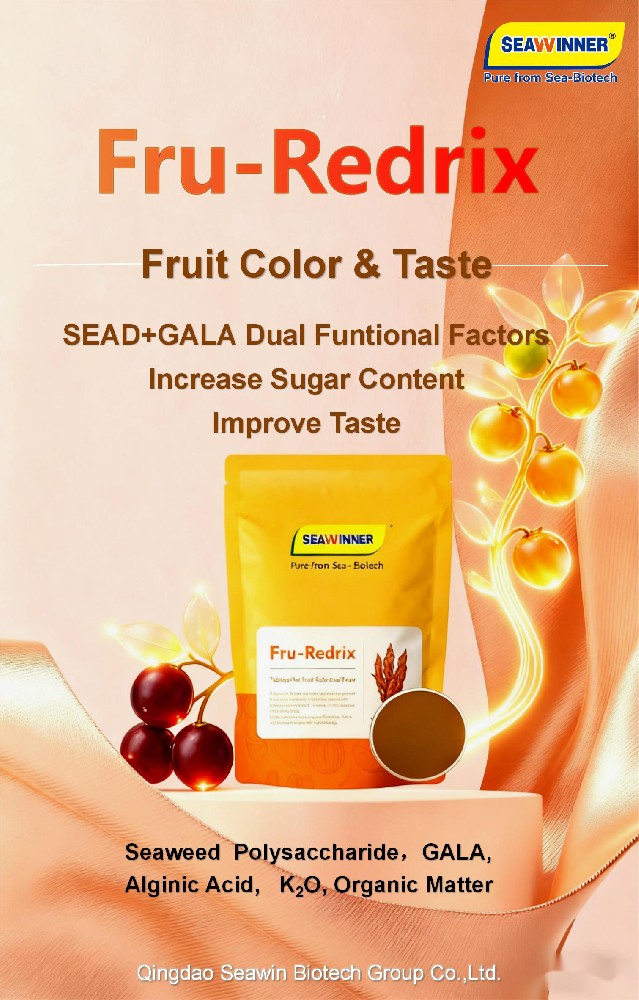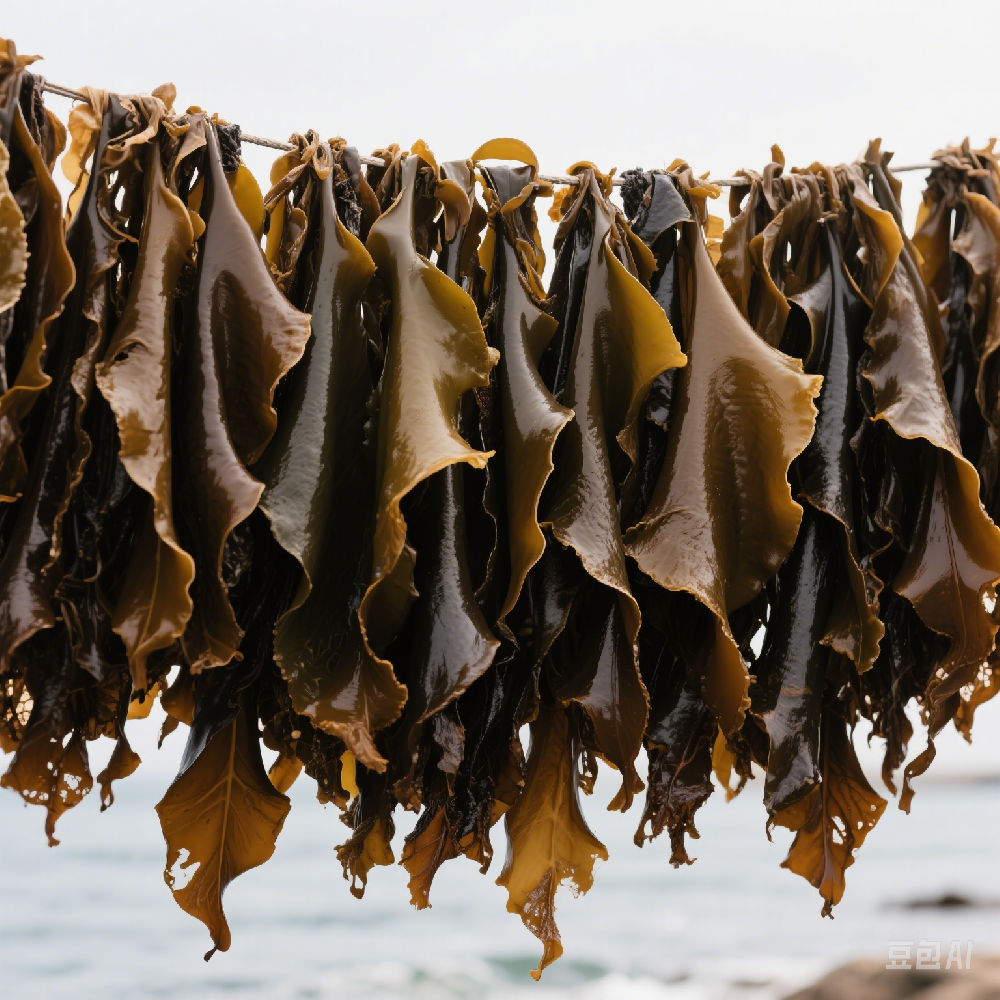In global agriculture, seaweed extracts have become one of the most prominent raw materials for biostimulants[1], driving innovation in crop nutrition and sustainable farming. For a long time, the market has been most familiar with Ascophyllum nodosum, which is almost regarded as the “standard raw material,” with its extracts dominating the market. However, with the advancement of scientific research and the upgrading of industrial chains, another brown seaweed — Laminaria Japonica[2] (kelp) — is gradually entering the international spotlight. Not only does it demonstrate unique advantages in active components, but it also provides a solid foundation for the widespread adoption of biostimulants[1] through sustainable cultivation and large-scale supply. Relying on China’s leading cultivation resources of Laminaria Japonica[2] and its independently developed targeted enzymatic hydrolysis technology, Qingdao Seawin Biotech Group has taken the lead in promoting the industrialization of Lamnaria Japonica seaweed extract in the biostimulant sector. It is also the lead registrant of enzymatic hydrolysis products of Laminaria Japonica under REACH.
Growth Environment and Origin of Laminaria Japonica
Laminaria Japonica is a large brown alga widely distributed in temperate and cold coastal waters. It is commonly found at depths of 5–20 meters in areas rich in mineral salts and with strong water currents, with an optimal growth temperature of 5–15 °C. Even under fluctuating tides and variable light conditions, Laminaria Japonica can grow rapidly, forming vast “underwater forests.” These ecosystems are not only vital for marine biodiversity but also serve as a premium raw material source for seaweed extracts and biostimulants applied in crop nutrition programs. China is the main producer of Laminaria Japonica. In particular, Rongcheng, Shandong Province—where Seawin Biotech’s Rantai factory is located—is renowned as the “hometown of Laminaria Japonica,” accounting for more than 80% of global production. With its favorable natural conditions and mature cultivation techniques, this region ensures both high quality andstable supply of Laminaria japonica for biostimulant seaweed extracts[1].
Active Components of Laminaria Japonica
Laminaria japonica contains a wide spectrum of active compounds that contribute to the effectiveness of seaweed extracts in biostimulant formulations. These substances not only play critical roles in kelp’s own growth and stress resistance but also deliver significant benefits when applied to crop nutrition.
Polysaccharides[1] in Laminaria Japonica
Polysaccharides are among the most important bioactive components of Laminaria Japonica, mainly including alginate, fucoidan, and laminarin. Each of these polysaccharides possesses unique chemical structures and biological functions, and together they endow seaweed extracts with outstanding biostimulant properties, particularly in enhancing crop stress resistance and promoting crop health.
Alginate can form a breathable film on the surface of plant roots and leaves, reducing transpiration and improving soil structure. Through its carboxyl and hydroxyl groups, it exhibits strong chelation capacity, thereby increasing the availability of micronutrients such as iron, zinc, manganese, and copper. In soil, alginate can be gradually degraded by microorganisms into smaller alginate oligosaccharides (AOS). These AOS molecules act as powerful signaling agents, capable of inducing plant resistance and stimulating growth.
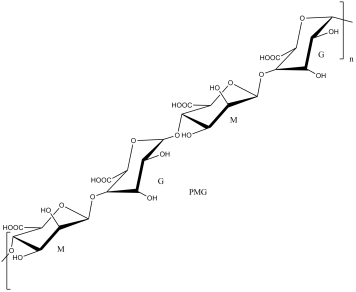
Figure 1: One of Alginate Structures
Fucoidan contains a unique sulfated structure that can activate plant immune responses and induce systemic acquired resistance (SAR). It plays a significant role in disease prevention and enhancing plant defense mechanisms.
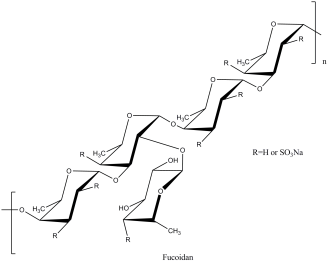
Figure 2: One of Alginate Structures
Laminarin functions as a signaling molecule to induce plant defense responses, thereby enhancing crop stress resistance.
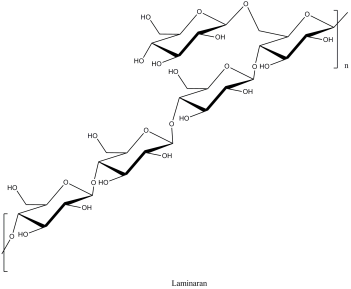
Figure 3: One of Laminarin structure
Other Active Components in Laminaria Japonica
Minerals and Trace Elements
Laminaria Japonica is rich in potassium, calcium, magnesium, as well as iodine, iron, zinc, and other elements. Among them, iodine content[1] is significantly higher than in most other algae, contributing to enhanced photosynthesis and antioxidant activity. Iron and zinc act as cofactors for various enzymes, influencing plant growth and energy metabolism. These elements exist in organically bound or ionic forms, making them more readily absorbed and utilized by plants. As a result, they effectively correct nutrient deficiency symptoms and improve fertilizer use efficiency.
Phytohormone Analogs and Regulatory Substances
Laminaria Japonica contains various natural phytohormone analogs and signaling molecules that can externally regulate crop physiological processes: Auxins: such as indole-3-acetic acid (IAA), which promote cell division and elongation, particularly beneficial for root development and seedling growth.Cytokinins[1]: such as zeatin, which delay senescence, stimulate lateral bud initiation, and facilitate nutrient mobilization. Betaine: an important compatible solute that helps maintain osmotic balance and enzyme activity under salt and drought stress, thereby alleviating abiotic stress damage. Sterols: such as fucosterol, which exhibit certain hormone-like regulatory activities and contribute to stabilizing cell membranes.
Antioxidant Compounds
Laminaria Japonica is rich in natural antioxidant substances that help mitigate oxidative stress in crops:
Polyphenolic compounds[1]: such as phlorotannins, which possess strong free radical scavenging capacity and metal ion chelation ability. They reduce lipid peroxidation and protect the integrity of biological membranes.
Carotenoids[2]: including fucoxanthin and β-carotene, which function not only as accessory pigments in photosynthesis but also as quenchers of reactive oxygen species, enhancing photoprotection and stress tolerance. Vitamins: such as vitamin E and vitamin C, which participate in antioxidant defense through reduction–oxidation cycles and regeneration pathways. These compounds contribute to extending the functional lifespan of leaves, improving postharvest quality, and providing significant benefits under stress conditions such as high temperature and intense light.
Nitrogen-Containing Compounds
Amino acids: Laminaria Japonica contains more than 18 types of amino acids, including glutamic acid, alanine, and arginine. These amino acids can be directly absorbed by crops, promoting nitrogen metabolism, enhancing chlorophyll synthesis, and improving both root development and nutrient uptake.
Proteins: The crude protein content of Laminaria Japonica accounts for approximately 8–12% of its dry weight. After enzymatic hydrolysis, these proteins yield small peptides that play dual roles in stimulating plant growth and inducing resistance.
At present, Qingdao Seawin Biotech Group has realized the efficient extraction and preservation of Laminaria Japonica active components through targeted enzymatic hydrolysis technology. Based on this platform, the company has developed a variety of functional products derived from Laminaria Japonica extracts, providing an essential material foundation for the next generation of green, stress-resilient biostimulants.
Advantages of Laminaria Japonica as a Raw Material for Biostimulants
Laminaria Japonica is much easier to cultivate on a large scale, ensuring sustainable and stable supply. It also shows strong competitiveness in terms of cost, composition of active components, and functional performance.Rich and Comprehensive Active ComponentsLaminaria Japonica is abundant in diverse bioactive substances[1]. With advanced biotechnological extraction, these compounds can be effectively preserved, enabling multiple functions such as stimulating plant growth, enhancing stress resistance, and improving crop quality.
More Stable SupplyChina possesses the world’s largest Laminaria Japonica aquaculture industry chain, with a cultivation cycle of less than one year. Compared with Ascophyllum nodosum, which mainly depends on wild harvesting, Laminaria Japonica offers far greater supply stability.Superior Cost-EffectivenessThe high yield and large-scale farming of Laminaria Japonica significantly reduce raw material costs, providing greater price competitiveness. This cost-efficient production system strongly supports the global adoption of seaweed extracts[1] in agriculture.Conclusion and OutlookWith its renewable resources, diverse bioactive composition, and environmentally friendly profile, Laminaria Japonica[2] has become an important raw material for high-quality seaweed extract-based biostimulants. Qingdao Seawin Biotech Group Co., Ltd. has achieved high-value utilization of Laminaria Japonica and established a leading technological position in the industry by integrating origin resources, overcoming bottlenecks in enzymatic hydrolysis processes, and building a complete industrial chain. Looking ahead, as technologies such as enzyme optimization, molecular weight control, and precise formulation of functional components continue to advance, Laminaria Japonica-based biostimulants will further unleash their potential in sustainable and green agriculture.


